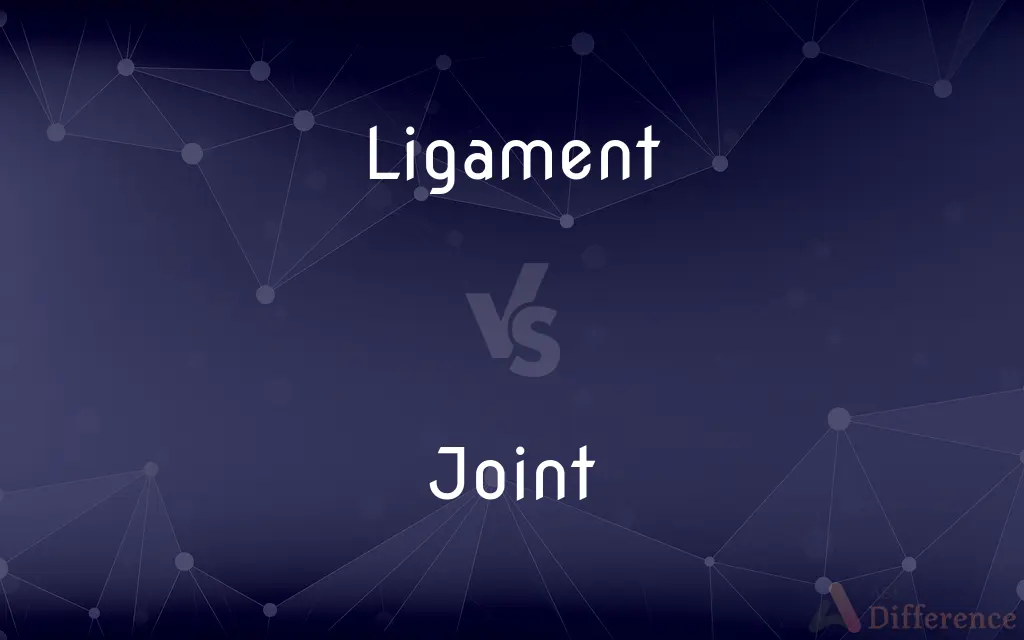Ligament vs. Joint — What's the Difference?
By Maham Liaqat & Fiza Rafique — Updated on April 1, 2024
Ligaments are tough, elastic bands of tissue that connect bones to each other, providing stability to joints. Joints are structures where two or more bones meet, allowing for movement and flexibility of the skeleton.

Difference Between Ligament and Joint
Table of Contents
ADVERTISEMENT
Key Differences
Ligaments play a critical role in stabilizing joints, preventing excessive movement that could lead to injury. They are composed mainly of long, fibrous collagen tissues, which give them the strength to hold bones together while still allowing for the flexibility necessary for movement. Joints, on the other hand, are the actual points of connection between bones, which can be classified into several types based on their structure and the movement they allow. These include fixed joints that allow no movement, like those in the skull, and synovial joints, like the knee or elbow, which are highly mobile.
The health and functionality of a joint depend significantly on the condition of its ligaments. Damaged or torn ligaments can lead to joint instability, increased risk of injury, and can affect the joint's range of motion. Conversely, the design of a joint – including how bones are shaped and arranged – determines the types of movement that are possible, the range of motion, and the overall function of that joint in the body.
Ligaments are specific to the joints they serve, with each ligament having a precise location and function, such as the anterior cruciate ligament (ACL) in the knee, which helps control forward movement and rotation of the tibia. Joints may contain several ligaments, cartilage (which cushions the ends of bones), synovial fluid (which lubricates the joint), and other structures that work together to allow smooth and controlled movements.
Recovery from injuries to ligaments and joints can vary widely. Ligament injuries, particularly sprains or tears, often require rest, physical therapy, or in severe cases, surgery to repair. Joint injuries might involve damage to any component of the joint, including bones, ligaments, cartilage, or the joint capsule itself, and the treatment and recovery process will depend on the severity and specific nature of the injury.
Culturally and symbolically, both ligaments and joints are often associated with flexibility, connection, and support within the body. While ligaments symbolize the strength and resilience of connections between bones, joints represent the importance of flexibility, movement, and adaptability in life.
ADVERTISEMENT
Comparison Chart
Definition
Bands of fibrous tissue connecting bones to each other, providing stability.
Structures where two or more bones meet, enabling movement.
Composition
Mainly composed of long, fibrous collagen tissues.
Can include bones, cartilage, ligaments, synovial fluid, and other tissues.
Function
Stabilize joints, limit excessive movement.
Allow for a range of movements depending on the type of joint.
Types
Named for the bones they connect or their position (e.g., ACL).
Classified by structure and movement (e.g., fixed, hinge, ball-and-socket).
Injury and Recovery
Injuries often involve sprains or tears, requiring rest, therapy, or surgery.
Injuries can involve any component, with recovery depending on the specific nature and severity.
Compare with Definitions
Ligament
Connective tissues that link two bones together within a joint.
The ACL ligament in her knee was injured during the soccer game.
Joint
The points where two or more bones meet, allowing for movement.
Arthritis can cause inflammation in various joints, like the knees and hands.
Ligament
Provide stability and limit the range of motion to prevent injury.
Stretching helps strengthen ligaments around the joints for better stability.
Joint
Can be immovable, slightly movable, or freely movable.
The skull is made up of immovable joints that protect the brain.
Ligament
Can be stretched or torn, leading to joint instability.
He's recovering from a torn ligament, which has made his ankle very unstable.
Joint
Include structures such as cartilage and synovial fluid to facilitate movement.
Healthy joints have enough synovial fluid to prevent the bones from rubbing together.
Ligament
Essential for the proper functioning of joints.
Ligaments around the shoulder joint ensure it moves smoothly without dislocating.
Joint
The type of joint determines the direction and range of movement.
Ball-and-socket joints, like the hip, allow for more extensive movement than hinge joints like the elbow.
Ligament
Have a limited blood supply, which can slow the healing process.
Due to its poor blood supply, the ligament takes longer to heal.
Joint
Subject to wear and tear, injuries, and diseases that can limit functionality.
Over time, wear and tear on the joints can lead to conditions like osteoarthritis.
Ligament
A ligament is the fibrous connective tissue that connects bones to other bones. It is also known as articular ligament, articular larua, fibrous ligament, or true ligament.
Joint
A joint or articulation (or articular surface) is the connection made between bones in the body which link the skeletal system into a functional whole. They are constructed to allow for different degrees and types of movement.
Ligament
(Anatomy) A sheet or band of tough, fibrous tissue connecting bones or cartilages at a joint or supporting an organ.
Joint
A place or part at which two or more things are joined.
Ligament
A unifying or connecting tie or bond.
Joint
A way in which two or more things are joined
A mortise-and-tenon joint.
Ligament
(anatomy) A band of strong tissue that connects bones to other bones.
Joint
A point of articulation between two or more bones, especially such a connection that allows motion.
Ligament
(figurative) That which binds or acts as a ligament.
Joint
A point in the exoskeleton of an invertebrate at which movable parts join, as along the leg of an arthropod.
Ligament
Anything that ties or unites one thing or part to another; a bandage; a bond.
Interwoven is the love of liberty with every ligament of your hearts.
Joint
(Botany) An articulation on a fruit or stem, such as the node of a grass stem.
Ligament
A tough band or plate of dense, fibrous, connective tissue or fibrocartilage serving to unite bones or form joints.
Joint
(Geology) A fracture or crack in a rock mass along which no appreciable movement has occurred.
Ligament
A sheet or band of tough fibrous tissue connecting bones or cartilages or supporting muscles or organs
Joint
A large cut of meat for roasting.
Ligament
Any connection or unifying bond
Joint
A cheap or disreputable gathering place
"The tavern is ... just a joint with Formica tables, a vinyl floor, lights over the mirrors" (Scott Turow).
Joint
A building or dwelling.
Joint
A prison. Often used with the.
Joint
(Slang) A marijuana cigarette.
Joint
Vulgar Slang A penis.
Joint
Shared by or common to two or more
Our joint presence.
A joint income-tax return.
Joint
Sharing with another or others
A joint tenant.
Joint
Formed or characterized by cooperation or united action
Joint military maneuvers.
Joint
Involving both houses of a legislature
A joint session of Congress.
Joint
(Law) Regarded as one, especially with regard to tort liability or interest in property.
Joint
(Mathematics) Involving two or more variables.
Joint
To combine or attach with a joint or joints
Securely jointed the sides of the drawer.
Joint
To provide or construct with joints
Joint a boom on a crane.
Joint
To separate (meat) at the joints.
Joint
Done by two or more people or organisations working together.
The play was a joint production between the two companies.
Joint
The point where two components of a structure join, but are still able to rotate.
This rod is free to swing at the joint with the platform.
Joint
The point where two components of a structure join rigidly.
The water is leaking out of the joint between the two pipes.
Joint
(anatomy) Any part of the body where two bones join, in most cases allowing that part of the body to be bent or straightened.
Joint
The means of securing together the meeting surfaces of components of a structure.
The dovetail joint, while more difficult to make, is also quite strong.
Joint
A cut of meat, especially (but not necessarily) (a) one containing a joint in the sense of an articulation or (b) one rolled up and tied.
Set the joint in a roasting tin and roast for the calculated cooking time.
Joint
The part or space included between two joints, knots, nodes, or articulations.
A joint of cane or of a grass stem; a joint of the leg
Joint
(geology) A fracture in which the strata are not offset; a geologic joint.
Joint
A place of business, particularly in the food service or hospitality industries.
It was the kind of joint you wouldn't want your boss to see you in.
Joint
A place of resort for tramps.
Joint
An opium den.
Joint
Prison.
I'm just trying to stay out of the joint.
Joint
(slang) A marijuana cigarette.
After locking the door and closing the shades, they lit the joint.
Joint
A syringe used to inject an illicit drug.
Joint
The penis.
Joint
Sense}} A thing.
A Spike Lee joint
Joint
(transitive) To unite by a joint or joints; to fit together; to prepare so as to fit together
To joint boards
A jointing plane
Joint
(transitive) To join; to connect; to unite; to combine.
Joint
(transitive) To provide with a joint or joints; to articulate.
Joint
(transitive) To separate the joints; of; to divide at the joint or joints; to disjoint; to cut up into joints, as meat.
Joint
(intransitive) To fit as if by joints; to coalesce as joints do.
The stones joint, neatly.
Joint
The place or part where two things or parts are joined or united; the union of two or more smooth or even surfaces admitting of a close-fitting or junction; junction; as, a joint between two pieces of timber; a joint in a pipe.
Joint
A joining of two things or parts so as to admit of motion; an articulation, whether movable or not; a hinge; as, the knee joint; a node or joint of a stem; a ball and socket joint. See Articulation.
A scaly gauntlet now, with joints of steel,Must glove this hand.
To tear thee joint by joint.
Joint
The part or space included between two joints, knots, nodes, or articulations; as, a joint of cane or of a grass stem; a joint of the leg.
Joint
Any one of the large pieces of meat, as cut into portions by the butcher for roasting.
Joint
A plane of fracture, or divisional plane, of a rock transverse to the stratification.
Joint
The space between the adjacent surfaces of two bodies joined and held together, as by means of cement, mortar, etc.; as, a thin joint.
Joint
The means whereby the meeting surfaces of pieces in a structure are secured together.
Joint
A projecting or retreating part in something; any irregularity of line or surface, as in a wall.
Joint
A narrow piece of scenery used to join together two flats or wings of an interior setting.
Joint
A disreputable establishment, or a place of low resort, as for smoking opium; - also used for a commercial establishment, implying a less than impeccable reputation, but often in jest; as, talking about a high-class joint is an oxymoron.
Joint
A marijuana cigarette.
Joint
Prison; - used with "the".
Joint
Joined; united; combined; concerted; as, joint action.
Joint
Involving the united activity of two or more; done or produced by two or more working together.
I read this joint effusion twice over.
Joint
United, joined, or sharing with another or with others; not solitary in interest or action; holding in common with an associate, or with associates; acting together; as, joint heir; joint creditor; a joint bank account; joint debtor, etc.
Joint
Shared by, or affecting two or more; held in common; as, joint property; a joint bond.
A joint burden laid upon us all.
Joint
To unite by a joint or joints; to fit together; to prepare so as to fit together; as, to joint boards.
Pierced through the yielding planks of jointed wood.
Joint
To join; to connect; to unite; to combine.
Jointing their force 'gainst Cæsar.
Joint
To provide with a joint or joints; to articulate.
The fingers are jointed together for motion.
Joint
To separate the joints; of; to divide at the joint or joints; to disjoint; to cut up into joints, as meat.
Quartering, jointing, seething, and roasting.
Joint
To fit as if by joints; to coalesce as joints do; as, the stones joint, neatly.
Joint
(anatomy) the point of connection between two bones or elements of a skeleton (especially if the articulation allows motion)
Joint
A disreputable place of entertainment
Joint
The shape or manner in which things come together and a connection is made
Joint
A piece of meat roasted or for roasting and of a size for slicing into more than one portion
Joint
Junction by which parts or objects are joined together
Joint
Marijuana leaves rolled into a cigarette for smoking
Joint
Fit as if by joints;
The boards fit neatly
Joint
Provide with a joint;
The carpenter jointed two pieces of wood
Joint
Fasten with a joint
Joint
Separate (meat) at the joint
Joint
United or combined;
A joint session of Congress
Joint owners
Joint
Affecting or involving two or more;
Joint income-tax return
Joint ownership
Joint
Involving both houses of a legislature;
A joint session of Congress
Common Curiosities
What is the main function of ligaments?
Ligaments primarily provide stability to joints, limiting excessive movement to prevent injury.
How can ligament and joint health be maintained?
Maintaining a healthy weight, regular exercise, stretching, and a balanced diet can help keep ligaments and joints healthy.
Why are some joints more flexible than others?
The range of flexibility depends on the type of joint and the arrangement of its supporting structures, including ligaments and muscles.
What is the difference between arthritis and ligament damage?
Arthritis affects the joints, causing inflammation and pain, while ligament damage specifically involves the tearing or stretching of ligaments.
How do joints facilitate movement?
Joints allow bones to move in relation to each other, facilitated by structures like cartilage, synovial fluid, and, importantly, the type of joint (e.g., hinge, ball-and-socket).
What happens when a ligament is stretched too far?
Overstretching a ligament can lead to a sprain or tear, resulting in pain, swelling, and joint instability.
How do age and activity level affect joints and ligaments?
With age and activity, joints and ligaments can experience wear, leading to reduced flexibility and increased risk of injury.
Can ligaments heal after an injury?
Ligaments can heal, but the process is often slow due to their limited blood supply. Severe tears may require surgery.
Are all joint movements controlled by ligaments?
While ligaments play a significant role in limiting and guiding movement, muscles primarily drive the movement across joints.
Can joint replacements restore full mobility?
Joint replacements can significantly improve mobility and reduce pain, but the outcome can vary based on individual conditions and rehabilitation.
Share Your Discovery

Previous Comparison
Afro vs. Fro
Next Comparison
Implication vs. InferenceAuthor Spotlight
Written by
Maham LiaqatCo-written by
Fiza RafiqueFiza Rafique is a skilled content writer at AskDifference.com, where she meticulously refines and enhances written pieces. Drawing from her vast editorial expertise, Fiza ensures clarity, accuracy, and precision in every article. Passionate about language, she continually seeks to elevate the quality of content for readers worldwide.














































